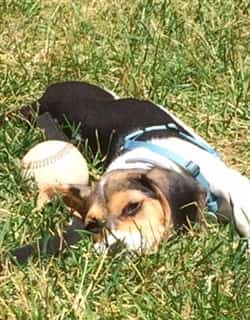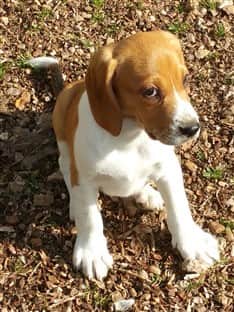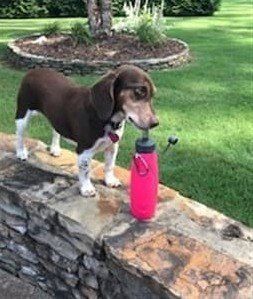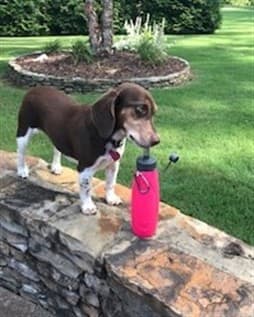Can a Beagle Do Okay Living Outside?

Overview
Please note: BeaglePro is reader-supported, and some of the product suggestions on this page are affiliate links. As an Amazon Associate we earn from qualifying purchases. This is at no extra cost to you and helps us keep this site running.
Did Beagle Hunting Dogs Live Outside?
With the Beagle’s rich history of being pack hunting dogs, one may first assume that the answer is yes, or at least that they once were.
The height of popularity for using Beagles as hunting dogs
was during the late 1800’s and early 1900’s. However, even today, though greatly diminished, this is still a sport.

Cathead Biscuit, at 10 weeks old,
photo courtesy of Diane
It is true that Beagle hunting packs spent their days running through fields chasing down, mainly, rabbit. And when the chase was done, it was not uncommon for a Beagle pack to sleep outside of the main house.
However, there are two important components to keep in mind.
One, is that those Beagles often slept outside in a roofed kennel or at least under a covered shelter; many of these had hay on the flooring. This offered protection from the outdoor elements such as rain and wind. The roof, or in some cases sides too, helped to keep the area warm.
The other element is that when Beagles slept outside in these shelters, they did so together as a pack. You may wonder how many Beagles were in packs. Most held a minimum of 5 Beagles, 8 to 14 was considered standard, and some had 20+.
So, when Beagles slept outside, they did so cuddle together, and thanks to thermodynamics, kept each other warm.
In summary, though the hunting Beagles of past did spend quite a bit of time outside, and many did sleep outside, they did so in groups and under cover of shelter.
Beagles are not outside dogs in any way comparable with Arctic or Siberian breeds that can endure extreme weather conditions. In addition, today’s Beagle has a personality trait that makes it exceedingly difficult for him to be happy outside alone, and we’ll dive into this next.
The Beagle’s Personality and How This Relates to Living Outside
During centuries of refined breeding, work was done to achieve several admirable traits with the Beagle. Aside from a high energy level
and the love of ‘the chase’, there was something else that was needed… Dogs that are aloof are not helpful in the field, so very strong bonding was an important personality trait that was cultivated.
And, as most Beagle owners will attest to, this personality trait has remained solid. Today’s Beagle is wants to be with his owner. His human family is his ‘pack’. There is nothing quite comparable to how this breed soaks in love from his family and how he feels secure inside the home, which is his ‘den’ that holds his ‘pack’.
This is not to say that Beagles don’t like being outdoors. They do. In fact, if a Beagle does not spend enough time out and about, he can become very restless and unhappy. This can result in negative behavior including but not limited to excessive barking, howling, and destructive chewing. However, time outside should be supervised by owners (we’ll cover much more of this ahead) and a shared event.
You may now be wondering, well, what about if there’s more than one Beagle? Can two or more Beagles be happy living outside, because they’ll have each other for company?
The answer is that yes, having multiple Beagles outside by themselves would eliminate a good portion of the isolation that a single Beagle would feel. However, there are physical limitations to take into consideration, and this is what we’ll cover next.
What Weather Conditions Can a Beagle Safely Endure?

If you let a Beagle be outside for a full day, or live outside meaning sleeping there as well, a huge factor in the dog’s safety would be the weather; both heat and cold extremes.
Precipitation plays a role as well, since rain or snow would affect the speed at which hypothermia would develop.
In general, most of today’s canine pets (this excludes sled dogs, etc.) can easily tolerate temperatures between 50 F and 80 F without issues. Factors that affect a dog’s tolerance level include age, health status, and level of hydration, among others.
During cold weather, both hypothermia (abnormally low body temperature, below 98 F body temperature for canines) and frostbite are concerns for dogs that are left outside.
With hypothermia, the exact time that it takes for this to develop in dogs is dependent on the air temperature, wind chill factor, if the dog is wet (from rain or snow), and the dog’s age and health status.
Generally, if it is right at the freezing mark (32 F) and owners are supervising, a Beagle can safely be outside 45 minutes to 1 hour. This time decreases as the temperature drops.
With frostbite, the ears, nose, tail, legs, and genitals are areas that are often affected first. When looking how cold it has to be for a Beagle to get frostbite, you have to look at the wind chill factor. On a cold day of just 5 F and with a wind of 30 MPH, frostbite can set in after 30 minutes. On a severely cold day of -20 F with a 15 MPH wind, it could develop in as little as 10 minutes.
During hot weather, heat stroke (body temperature over 104 F) is a major concern for dogs that are outside. How hot is too hot for a Beagle depends quite a bit on if the dog is active and his level of hydration. Owners are encouraged to be on guard any time it is over 90 F.
Full List of Dangers if a Beagle is Outside Alone

Roscok, at 8 months old,
photo courtesy of Savannah Merckling
All of these potential issues should be taken into account:
- Hypothermia – A top concern during the winter.
- Heat stroke – A top concern during the summer.
- Escape - Even from fenced yard this can happen; dogs can try to jump or even dig under a fence. Un-neutered males are the most prone to try and take off running.
- Ingestion of dangerous objects or toxic plants. Dogs, particularly those that are bored, will mouth (and possibly ingest) all sorts of yard debris including small rocks. And many common flowers, vines, shrubs, and trees are poisonous to canines. Plant poisoning is among the top 5 toxins for dogs.
- Wild animals – Coyotes, which are known to attack dogs, live in every single state in the US except for Hawaii. Cougars are found along the west coast. But even smaller non-predatory animals can present dangers as well; both opossums and raccoons can bite if engaged and can carry rabies or flea-borne diseases.
Chasing down small animals such as squirrels can present a risk as well; this includes transmission of diseases, including leptospirosis which harbors in rodents and a disease that not all dogs are vaccinated for.
Better Alternatives Than Having a Beagle Live Outside
For owners that are considering having their Beagle live outside, or spend a good portion of their days outside, this is often due to the dog’s behavior in the house. This may include negative behaviors such as excessive barking or destructive chewing. And/or it may include signs that the Beagle wants to be outside more such as restlessness or even escape attempts.

Beauregard, at 2 and 1/2 months old,
photo courtesy of Amy
However, since being outdoors alone is not safe and can be exceedingly isolating and lonely for a dog, we suggest nixing the idea of having your Beagle outside by himself, and instead focus on fixing issues you've seen when he is inside.
Here are some things that can be done:
1. Schedule daily walks.
Beagles are very active dogs and most do best with at least 2 and often 3 walks per day. Duration should be for at least 20 - 30 minutes and at a pace that is brisk for the dog.
2. Provide outside play.
If you just let a Beagle outside by himself with no stimulation, he’s not going to be very happy. He may not even be very active; he may run a few laps at first, but soon he’ll sniff around a bit, and then become rather bored.
So, let this be supervised time where you are actively playing with your dog. Never underestimate the classic game of Fetch.
If your Beagle needs incentive, remember that the type of toy you throw and your level of enthusiasm will make a big difference.
Try throwing a KONG Wubba Toy ; this is a tennis ball on top of a squeaker ball, wrapped in durable material and with a trailing tail. It comes in bright colors, and 3 sizes.
; this is a tennis ball on top of a squeaker ball, wrapped in durable material and with a trailing tail. It comes in bright colors, and 3 sizes.
3. Expand your Beagle’s world.
Beagles love to explore, so seeing the exact same sights each day can be too repetitive. You can expand his world a bit by taking new walking routes. Or, you can expand it a lot by heading out to new places. This can include hiking trails, dog parks, visiting pet supply stores, going to a lake shore or beach, flea markets, farmer’s markets, etc.
4. Play scenting games.
Beagles love to chase down scents, and you can offer this sort of fun by hiding highly scented treats or a toy that holds a strong scent (dip a paper towel in bacon grease, dab this on the toy) either in the house (if the weather’s bad) or outside in the yard.
You can use more clever hiding spots to make this more challenging as your dog learns how to play the game.
If outside, keep your Beagle on leash. If you’ve marked a toy, allow your Beagle a whiff of the scent, and then give commend to ‘Find’ with a prompt in the right direction. Most Beagles catch on very quickly.
5. If your Beagle has chewing tendencies
that make living outside seem like a tempting idea, take steps to limit access and provide appropriate toys to chew on.
You can limit access by proofing the house (remove items from the floor, place cords out of the way or use cord protector) and block off certain rooms using gates.
Provide toys that offer chewing satisfaction. Kongs are a great go-to for this. These are color coded.
The red ones, like the KONG Stuff-A-Ball Toy
 are for adult dogs that are average chewers.
are for adult dogs that are average chewers.
The black ones like the KONG Extreme Goodie Bone Dog Toy, Medium, Black
 are for super aggressive chewers.
are for super aggressive chewers.
With these types of Kongs that are meant to hold food to encourage chewing, one tempting method is to fill these with a mixture of 100% all-natural smooth peanut butter and your Beagle’s kibble.
7. If your Beagle is barking a lot, those daily walks and bouts of playtime that we covered should cut down on this. In addition:
1-
Limit triggers (close blinds, use ethical methods to keep wildlife out of the yard, etc.).
2-
Work on interrupting and refocusing. You can interrupt with a loud hand clap or a behavior interrupter like The Company of Animals Pet Corrector , which lets out a short hissing noise that causes dogs to take pause. Then, refocus by offering a ‘new’ toy.
, which lets out a short hissing noise that causes dogs to take pause. Then, refocus by offering a ‘new’ toy.
Always keep a few fun toys hidden away to use for times like this. One that actively engages a dog can keep a Beagle interested and focused on the toy. Those that speak or make silly noises like the Babble Balls (see below) are terrific for this.
Below are some of the toys we’ve mentioned, including the Wubba which is great for fetch, a Kong Stuff-a-Ball which is terrific to satisfy chewing urges, a Babble Ball to keep a Beagle busy, and the corrector we covered to interrupt barking.
If you do not see the images, try a refresh, and on mobile you may need to turn your screen horizontal to see all 4.
A Final Word
Today’s pet Beagles are indoor dogs that really enjoy time outside; but they should be outdoors under owner supervision. When you take the time to address issues that may occur inside and spend more time with your Beagle outside, you’ll find that your Beagle puppy or dog is happier and more well-behaved.
Other Helpful Articles:
Helping a Beagle with Car Sickness
- Don't let motion sickness prevent you from taking your Beagle along with you. These steps can help both puppies and dogs do okay in the car.
Top Beagle Care Tips
- Follow these 7 tips for optimal health, comfort, safety, and happiness.
Helping a Beagle with Separation Anxiety
- If your Beagle hates being home alone, there are things you can do to help him cope during this time.
See also:
Beagle Facts
- Interesting facts and info about the Beagle breed.



